
Beyond The Fringe (1961)
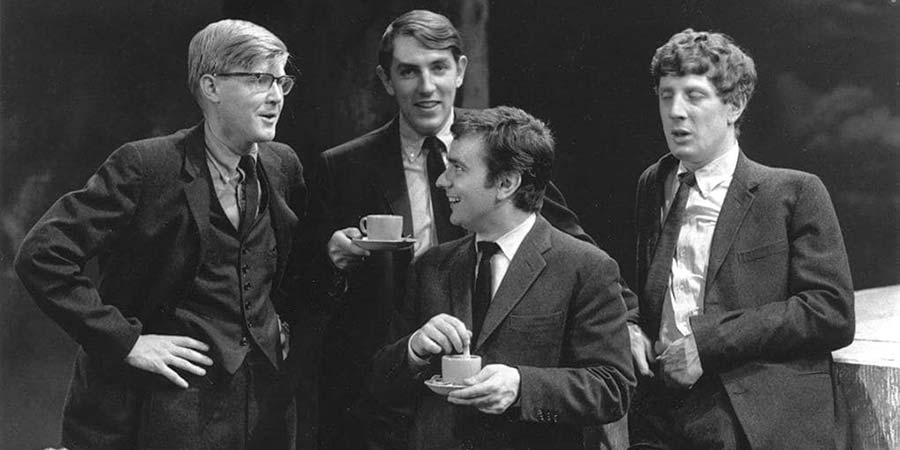
1961 - Alan Bennett, Peter Cook, Jonathan Miller, Dudley Moore
Beyond The Fringe
Parlophone PMC1145
The four young men who walked out onto the bare stage of Edinburgh's Royal Lyceum Theatre on 22nd August 1960 did not look like revolutionaries. Smartly dressed in suits and ties, with dark woollen sweaters, they looked more like trainee bank clerks or accountants. Sober and respectably attired they may have been, but within the space of a year they would revolutionise the world of comedy and pave the way for some of the most innovative comic performers of the 20th Century.
Mounted every August since its establishment in 1947 (the pandemic-cursed year of 2020 aside), the Edinburgh International Festival brings music, theatre, opera and dance from around the world to Scotland's capital. Centred around the city's major theatres and concert halls, it soon became eclipsed by the much more anarchic Edinburgh Festival Fringe. Consisting of thousands of artists, the Fringe has grown to become the world's largest festivals of the arts: each year pubs, church halls, schools, tents, university rooms, and on occasion public toilets, are packed with the hopeful, the hopeless, the dazzling, the deluded and the aspiring talents of the contemporary arts scene.
Having grown alongside the 'proper' festivals in a ramshackle manner, by the late 1950s the Fringe was becoming a serious challenger to its more earnest and restrained parent. With low ticket prices, late opening hours, small informal venues and myriad shows abounding around the city, how could the Festival compete with this unruly upstart? It was a question that the Festival's increasingly frustrated artistic director Robert Ponsonby resolved to address.
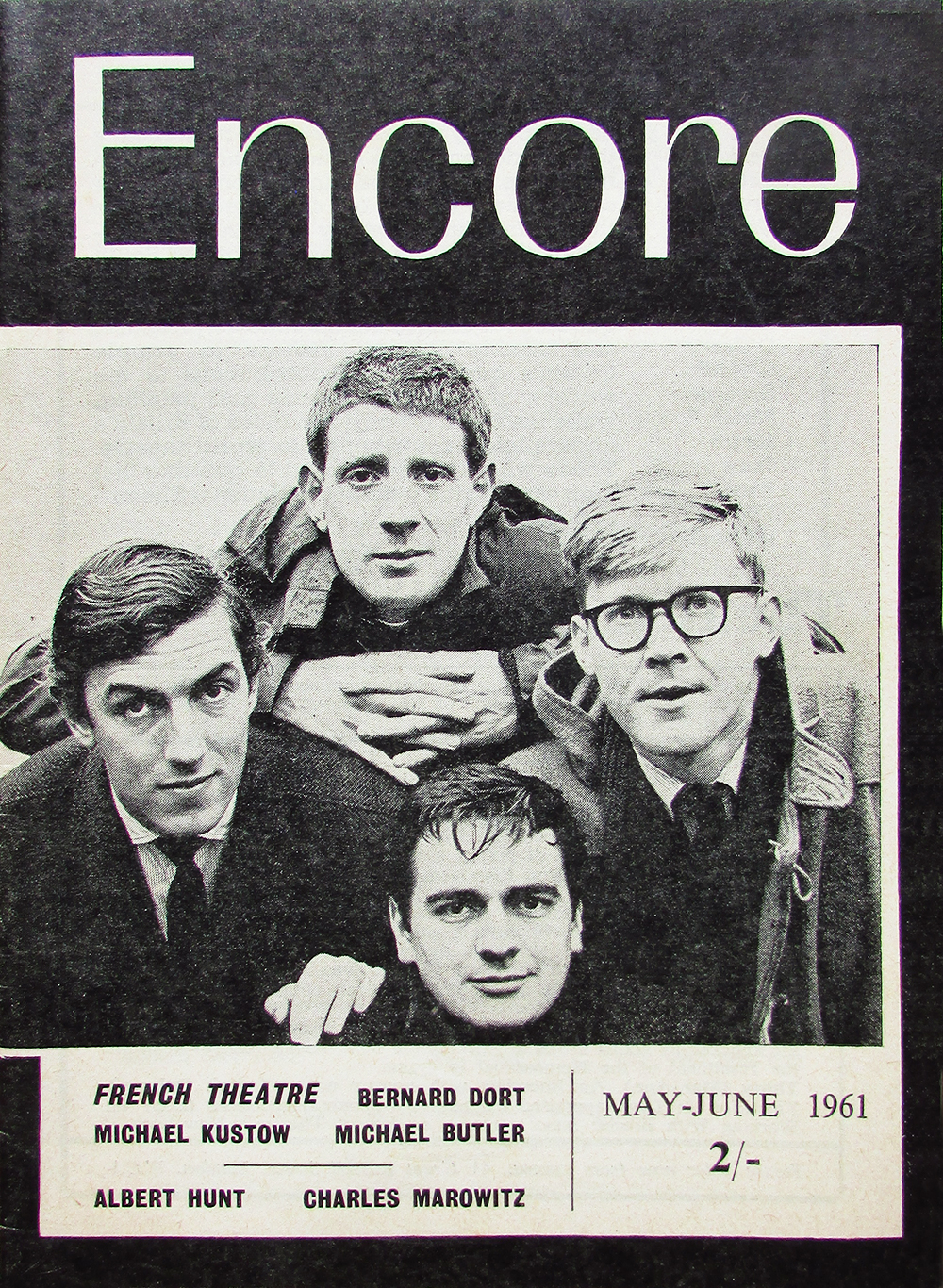
His solution was to adopt a populist approach to pull in paying customers and stage a revue. With a light-hearted blend of music, dance, and comic sketches, such revues are a rarity these days but were a staple of the West End in the 1950s. Genteel, erudite and lightly comic, with just the slightest hint of the subversive, revues appealed to the sort of middle class festival-goers Ponsonby wanted to attract, while still being something mildly daring and different amid all the more sober opera and classical music on offer at the Festival.
His first revue in 1958 featured Anna Russell presenting her comic takes on classical music and ran for a week at the Freemasons' Hall. She returned for another short run in 1959, this time at the Lyceum, with Flanders & Swann performing at the venue for the second week of the Festival. For 1960 Ponsonby decided to stage a whole three weeks of late night shows with a truly international star - none other than musician Louis Armstrong. Unluckily for the Festival, but luckily for British comedy, negotiations with the great jazzman fell through, leaving Ponsonby with a large gap in his schedules to fill.
Inspired by the numerous clever and witty Fringe revues mounted each year by university students, Ponsonby resolved to build his own college-style revue, calling on the talents of the brightest minds of Oxford and Cambridge universities to be called somewhat prosaically The Oxbridge Revue. Fortuitously for him, his assistant artistic director John Bassett had recently graduated from Oxford, where he had played in a jazz band with fellow student and now professional musician, Dudley Moore. The ball had started rolling...
After Bassett signed Moore on board, Moore in turn recommended Alan Bennett, who was by then then studying for a Master's in medieval history. To balance these two Oxford talents, Bassett sought out two more recent graduates from Cambridge. His first stop was to the casualty department of University College Hospital in London where he called on Dr Jonathan Miller, whom he had seen perform in a number of revues as a student. For the fourth piece of the jigsaw he recruited another Cambridge talent, the acclaimed writer of the recent West End success One Over The Eight, Peter Cook. As artificially brought together as any musical boy band, it was a daring enterprise with no guarantee of success. Luckily the balance of talents and temperaments gelled perfectly from their first meeting. Initial hostility and mistrust soon turned to mutual support and comic brilliance.
Peter Cook was talkative, inventive, witty and inspired; innovative improvisation flowed naturally from him from the group's first meeting. Jonathan Miller too was filled with confidence and inspiration, and contributed many fanciful ideas to the group. Moore and Bennett were less forthcoming initially, and lacked the bold assurance of their Cambridge colleagues. Gradually though, they too would start contributing material; Bennett with his mock sermons and Moore with his witty musical pastiches. For the four months before the Festival, the quartet rehearsed, wrote and improvised in London, often in Jonathan Miller's hospital accommodation where he remained on call for various medical procedures.
Before its Edinburgh debut the revue was renamed by Ponsonby to Beyond The Fringe, in order to mark its distinction from the many typically disorganised amateur productions that populated the Fringe. Whether the retitling worked and the distinction of it not being part of the Fringe was made is hard to say as the name has caused much confusion over the years. When the show opened at the Lyceum (not as part of the Fringe) late on that August night in 1960, directly after an Old Vic production of The Seagull, it was in a venue only 35% full. But as word spread about the new production and reviews came in, it quickly became the hottest ticket in town. For the rest of the week, the venue was filled to 120% of capacity with rows of eager theatregoers standing on every level of the building, contravening every fire regulation in the process. A West End run seemed inevitable and after William Donaldson secured the rights to the play, the four young performers would take their show south.
Only around half of the material performed in Edinburgh would be used in the London show. After that August run the team were booked into Cambridge Arts Theatre, where they opened in April 1961. With additional material written in the intervening months the revue was now running twice as long. The student-dominated audience of Cambridge were impressed but another brief run at the Theatre Royal Brighton the following month demonstrated just how much the show needed supervising and editing before transferring to the West End.
Beyond The Fringe is best remembered for its satirical and daring attacks on authority figures, but for the most part, the sketches that ended up being performed on stage in London, and those that made it onto the subsequent soundtrack album, are not satirical in the truest sense of the word. Most are just simply hilarious sketches; well-wrought, highly amusing and as funny today as they were some sixty years ago, but certainly not seditious or subversive.
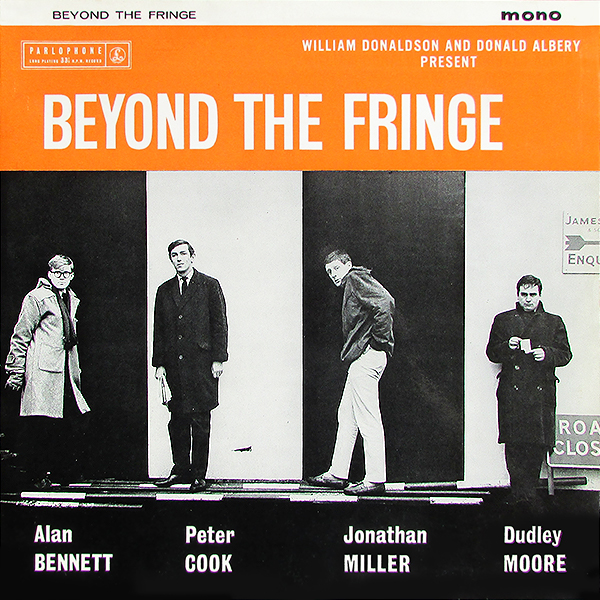
Produced by a pre-Beatles George Martin, all of the four players contribute a sketch or two to the Beyond The Fringe album. Jonathan Miller's The Heat-Death Of The Universe is a wonderfully realised and delivered piece of light-hearted comedy, postulating various theories to explain the prevalence of discarded trousers in London Transport's lost property offices. Dudley Moore has two musical numbers to demonstrate his considerable musical skills and ability to mimic classical composers in the tracks Deutscher Chansons and Little Miss Britten, which see him lampoon the likes of Fauré and Schubert, as well as Benjamin Britten and his muse Peter Pears.
Cook contributes typical oddities like Bollard, which sees a troupe of camp actors mincing their way through a cigarette commercial that calls on them to portray butch fishermen. Alan Bennett pontificates from the pulpit with his rambling, discursive sermon Take A Pew, concluding that Esau is indeed an hairy man, and that life is very much like a tin of sardines.
The most satirical of the tracks seem to need either the insightful mind of Peter Cook, or come when the troupe's collective minds are combined. Cook's solo piece T.V.P.M., which was inspired by Harold Macmillan, is probably one of the best remembered of Beyond The Fringe's sketches, and the one that best encapsulates the show's ground-breaking iconoclastic spirit. In what was a watershed moment at the time, a serving British prime minster was not only impersonated, but openly mocked in a public theatre.
Cook's impression of Macmillan was well measured. What could have been a grotesque and exaggerated caricature is instead a carefully constructed and closely observed impression. The leader formerly known as 'Supermac' is presented as an aloof condescending grandfather figure, leading an uncaring and out-of-touch Conservative Party that is intent on preserving the inequities of society. With his doddering monotonic vagueness, bewildered bumbling statesmanship, memory lapses, and expensive trips around the world attempting to promote a mediocre, underachieving Britain, Cook's version of Macmillan is an affectionate creation in hindsight, but it was shocking at the time.
Prime minsters aside, the most dangerous and daring pieces of satire came in the form of The Aftermyth Of War and Civil War. Bennett, Cook, Miller, and Moore, unlike many of their contemporaries on the London stage, were not old enough to have served in the Second World War, although they had lived through it as children. With National Service having ended in 1960, the same year as the show's debut, for their generation the most recent experience of British military muscle-flexing had been the humiliating debacle of the Suez Crisis, which had led to the resignation of Anthony Eden and the succession of Macmillan in 1957. It may have only been fifteen years since the end of the Second World War but Britain was already a nation living on memories with increasing irrelevance on the international stage.
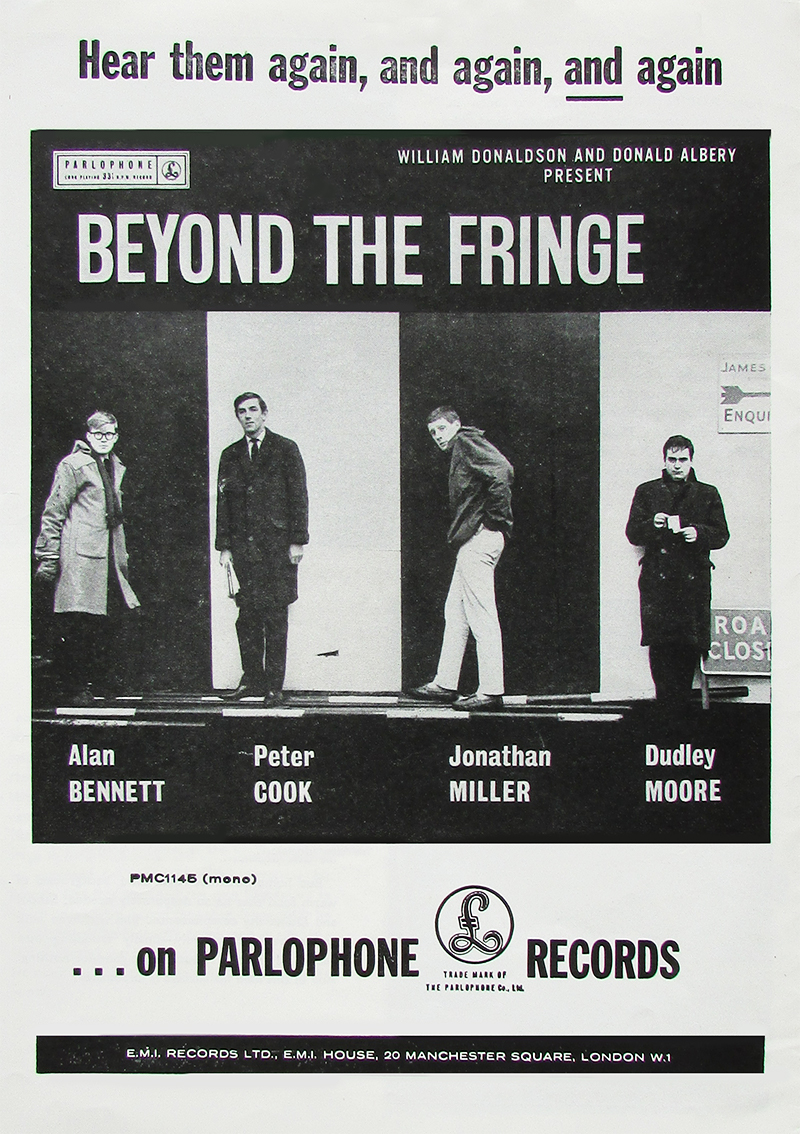
If ever a satirical eye needed casting over all the old British clichés of war films, of stiff upper lips, Spitfires over the briny, and stoic calm resolve, it was at this moment, and the young tyros of Beyond The Fringe were he perfect people to do it. Aftermyth Of War has brilliant moments from all of the performers. Peter Cook portrays a wonderfully dotty Cockney gardener more concerned with carrots and tea than the battles raging in the air above him; Bennett dons a headscarf to portray a society woman unable to stop the war due to Hitler not answering his phone. Dudley Moore provides various one liners and underscores the sketch with suitable musical cues, while Jonathan Miller steals the show with his RAF pilot urged by Cook to lay down his life in futile gesture designed to raise the general tone of the war. To the older generation who had served in the War, such audacious irreverence from young comedians was again astonishing and alarming.
Civil War, which opened both the second half of the show and the B-side of the album, continues in a similar vein, lampooning British military inadequacies, with a lack of firepower glossed over by jingoism, nostalgia and general delusion. With the growing and very real threat of nuclear war in the early 1960s, making light of annihilation by atomic bombs was a daring step. Cook delivers brilliant takes on the four minute warning, preparedness for war, and a number of useless tips on how to survive a nuclear strike (stay very still and don't stand under trees).
Elsewhere on the record, African leaders in newly independent nations are mocked in Black Equals White, and the respective class distinctions of the four performers are mocked in the brief sketch Real Class. The London show ended, as on the record, with The End Of The World, a typically surreal Cook sketch that sees the company gathered together as cult members atop a hill, gleefully awaiting the end of society and destruction of the world, an end which disappointingly never seems to come.
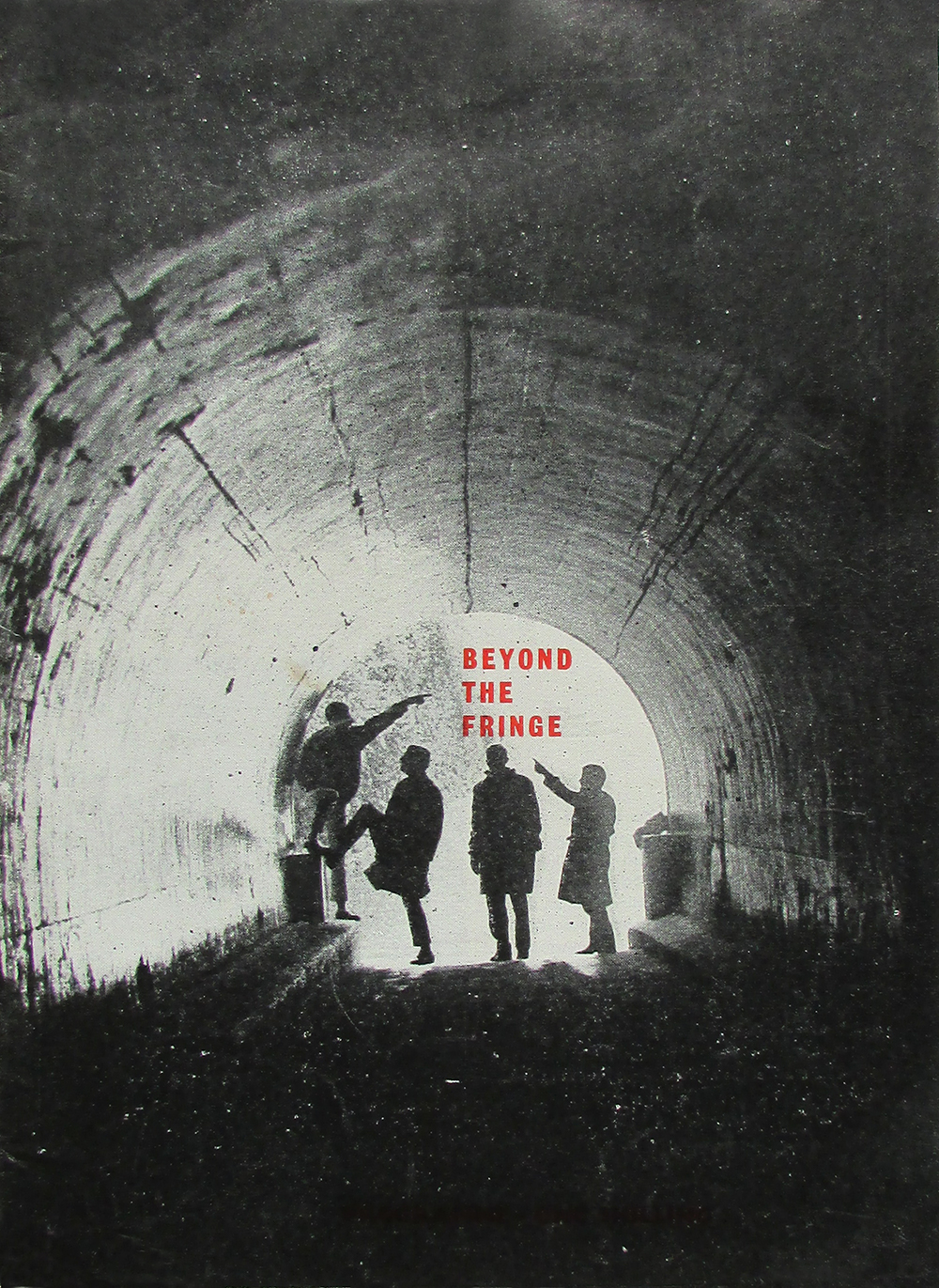
Originally planned to run for six weeks in London, Beyond The Fringe ran for over a year with the original cast. When it transferred to New York in 1962, a new cast would continue in the West End where the show ran, with subsequent revisions, until 1966. The Broadway version of the production saw two more soundtrack albums released; the second with Paxton Whitehead replacing Jonathan Miller, who had returned early to the UK. When Bennett, Cook, Miller, and Moore all eventually returned from New York in 1964 after that long and triumphant run, it was to a United Kingdom that had changed irrevocably - one that they had helped shape with their irreverence and iconoclasm.
A special performance was recorded for BBC Two but the country they had left now was now one dominated by youthful and independently minded people who took positive delight in upsetting the old order. Coincidentally their show also pretty much spelled the end for revues as an art form as well. Bare stages and minimal props had replaced lavish musical numbers, costume changes, ornate sets and troupes of dancing girls.
Beyond The Fringe has mellowed gracefully with time and is not nearly as shocking as it once was. TV and the theatre have seen much more outrageous and scandalous shows since it started the ball rolling all those years ago. It is a piece of its time, full of post-war anger directed at a complacent government that was increasingly out-of-touch with youth. Much more scathing, grotesque satire would follow, as would increasingly angry comedy, but Beyond The Fringe was a statement of intent, a catalyst to the social changes of the 1960s, and its cast the instigators of the comedy revolution that followed. It is as well, still extremely funny, and the soundtrack album remains a memorial to that wonderful moment in time.
Help us publish more great content by becoming a BCG Supporter. You'll be backing our mission to champion, celebrate and promote British comedy in all its forms: past, present and future.
We understand times are tough, but if you believe in the power of laughter we'd be honoured to have you join us. Advertising doesn't cover our costs, so every single donation matters and is put to good use. Thank you.
Love comedy? Find out moreThe Complete Beyond The Fringe

This CD collection contains two performance from the classic satirical stage show Beyond The Fringe.
The set contains both the 1961 London show and highlights from two shows from Broadway in 1962 and 1964.
First released: Monday 21st October 1996
- Released: Monday 19th April 2010
- Distributor: EMI
BCG may earn commission on sales generated through the links above.
- Distributor: EMI
- Discs: 3
- Minutes: 194
- Catalogue: CDBTF61
![]() Buy and sell old and new items
Buy and sell old and new items
Search for this product on eBay
BCG may earn commission on sales generated through the links above.
Beyond The Fringe - Live At The Cambridge Arts Theatre

This recording from 1961 is a special never-before released performance of the satirical review Beyond The Fringe, starring Peter Cook, Dudley Moore, Alan Bennett and Jonathan Miller.
Sketches include "Aftermyth Of War", "One Leg Too Few", "Take a Pew" and "The End Of The World".
First released: Monday 18th April 2011
- Distributor: EMI
BCG may earn commission on sales generated through the links above.
- Distributor: EMI
- Discs: 2
- Minutes: 139
- Catalogue: 0972772
![]() Buy and sell old and new items
Buy and sell old and new items
Search for this product on eBay
BCG may earn commission on sales generated through the links above.
